Ministry of Culture
Spiritual Powerhouses: Akharas at the Forefront of Maha Kumbh 2025
प्रविष्टि तिथि:
22 JAN 2025 4:02PM by PIB Delhi
The Akharas at the Maha Kumbh have long been the heart of the event, representing various traditions and sects of Sanatan Dharma. The word 'Akhara' is derived from 'Akhand,' meaning indivisible. These religious orders, which trace their origins to the time of Adi Guru Shankaracharya in the 6th century, have been the custodians of spiritual practices and rituals that have shaped the Kumbh Mela. With their distinct customs and leadership structures, the Akharas play a pivotal role in the spiritual and cultural life of the event, attracting millions of devotees from across the globe.
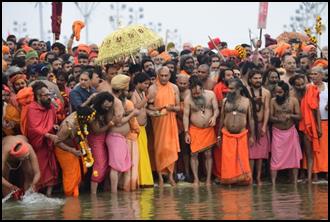
At the Kumbh, Akharas not only serve as places of worship but also as centers of spiritual learning and physical training. The Akhara system was established to promote the dual objectives of spiritual learning through scriptures and physical defense through martial arts. Today, these Akharas continue to uphold these principles while adapting to the changing times. The Mahamandaleshwaras, who lead the Akharas, play a key role in ensuring that both the spiritual and organizational aspects of the Akharas are properly maintained. Their leadership is central to the rituals and processions that define the Kumbh experience.
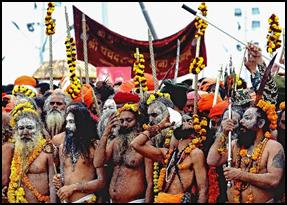
Among the 13 Akharas, the Shaiva, Vaishnav and Udaseen sects stand out for their deep spiritual significance. These Akharas contribute to the rich diversity of the Kumbh, with each bringing a unique perspective on devotion, worship, and community life. The Shaiva Akharas, for example, are led by Naga Sannyasis, ascetics who worship Lord Shiva and are known for their spiritual and martial prowess. These Naga Sannyasis, who carry traditional weapons like spears and swords, play an integral role in the grand processions and rituals of the Kumbh, particularly during the Shahi Snaan ceremonies.
The Naga Sannyasis of the Shaivite Akharas, particularly those of the Juna Akhara, are among the most revered participants of the Kumbh. Known for their rigorous ascetic practices and mastery of martial arts, the Naga Sannyasis carry the legacy of the Kumbh Mela’s spiritual warriors. The Juna Akhara, with its vast number of initiated Naga Sannyasis, continues to be a major spiritual force at the Kumbh, attracting devotees who seek both spiritual enlightenment and physical discipline.
One of the most historically significant Akharas is the Shri Panch Dashnam Aavahan Akhara, which has been part of the Kumbh Mela for over 1,200 years. Led by Mahant Gopal Giri, this Akhara has maintained the sacred tradition of the Chhari Yatra, a procession that carries the holy stick symbolizing divine authority. The Aavahan Akhara’s contribution to the Kumbh is rooted in preserving ancient practices while adapting to modern needs. Its continued presence underscores the timeless relevance of the Akharas in preserving the spiritual heritage of Sanatan Dharma.
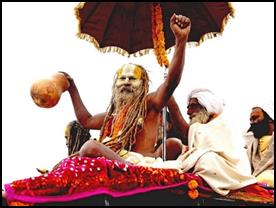
Vaishnav Akharas, including the Shri Panch Nirmohi Ani Akhada, Shri Panch Nirvani Ani Akhada, and Shri Panch Digambar Ani Akhada, also play a vital role in the Kumbh. These Akharas focus on the worship of Lord Vishnu, particularly in his incarnation as Lord Hanuman. The raising of Dharm Dhwajas (religious flags) bearing the image of Lord Hanuman signifies the divine protection and blessings bestowed on devotees, further enhancing the spiritual atmosphere of the event.

This Maha Kumbh is marking a significant shift in the spiritual landscape as for the first time ever, over 1,000 women are expected to be initiated into the prominent Akharas participating in the Maha Kumbh, with many already initiated into Sannyas, including women like Radhenand Bharti, a Ph.D. candidate in Sanskrit. The inclusion of women in the Akharas represents a growing recognition of their role in spiritual life, with some Akharas even creating distinct spaces for female monks.
A key player in this movement is the Shri Panchadashnam Juna Akhara, the largest and one of the most influential Akharas at the Kumbh. This Akhara has initiated over 200 women into Sannyas, and the number is expected to grow significantly. Furthermore, Juna Akhara has recently renamed its female monks' organization to Sannyasini Shri Panchadashnam Juna Akhara, giving it an official and respected identity within the spiritual community. In embracing gender equality, these Akharas are not only reshaping their internal structures but also empowering women to contribute actively to the cultural and spiritual fabric of India.

The Maha Nirvani Akhara, one of the wealthiest and most influential, is also at the forefront of gender empowerment. As the first Akhara to establish the position of Mahamandaleshwar for women, it continues to advocate for gender equality within the spiritual sphere. The participation of women Mahamandaleshwars, such as Sadhvi Geeta Bharti and Santosh Puri, further highlights the Akhara’s commitment to ensuring that women are given equal opportunities to lead and guide the spiritual community.
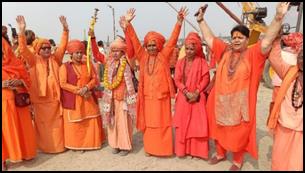
In addition to gender equality, the Maha Nirvani Akhara also emphasizes environmental conservation, reflecting the Akhara’s broader commitment to social and spiritual responsibility. This focus on sustainability aligns with the Kumbh’s role as a beacon of spiritual unity, where environmental consciousness is being increasingly integrated into the rituals and activities of the event.
Another significant development at the Kumbh is the growing presence of Kinnar Akharas, an inclusive space that welcomes the Kinnar community, traditionally marginalized within society. For the first time, a Kinnar Akhara is participating in the Maha Kumbh, marking a momentous occasion for both the event and the community. This Akhara embodies the principles of equality and respect, offering a platform for the Kinnar community to engage in spiritual practices alongside other sects of Sanatan Dharma.
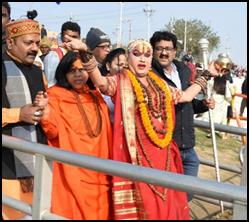
The Kumbh Mela, especially in 2025, stands as a testament to the enduring relevance of the Akharas in the spiritual life of India. These institutions not only preserve the spiritual and cultural values of Sanatan Dharma but also adapt to modern sensibilities, embracing inclusivity and equality. The Akharas at the Maha Kumbh continue to inspire millions of devotees, offering them a path to spiritual growth, discipline, and unity. As the grand processions unfold and the sacred rituals are performed, the Akharas remain the heart and soul of the Maha Kumbh, guiding the faithful toward a deeper connection with the divine and with each other.
References
Department of Information & Public Relations (DPIR), Government of Uttar Pradesh
https://kumbh.gov.in/en/spiritualgurus
Maha Kumbh Series: 19/Feature
Click here to see in PDF:
Santosh Kumar/ Sarla Meena/ Rishita Aggarwal
(रिलीज़ आईडी: 2095098)
आगंतुक पटल : 4746